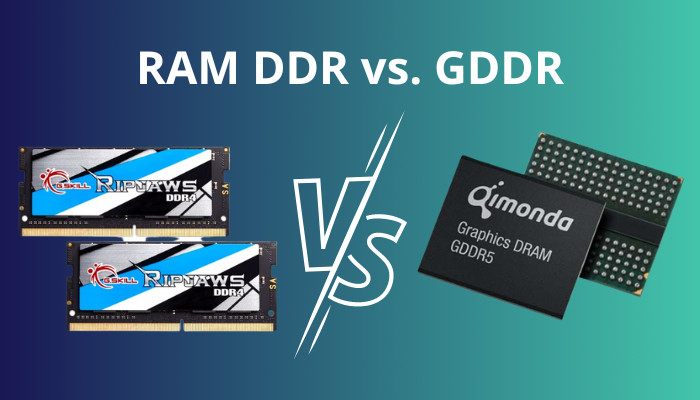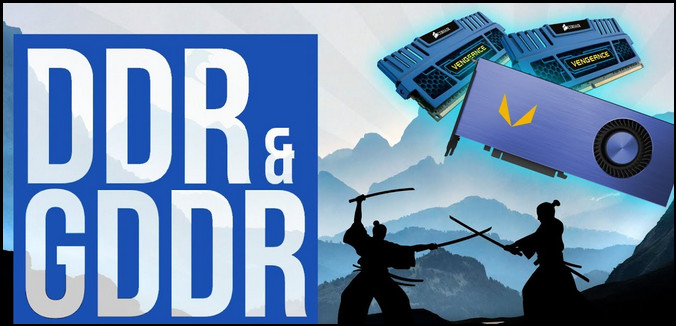Trying to determine what is DDR and GDDR and which one you should get for your PC?
There are two types of RAM used in your computer, namely DDR and GDDR, but you may not know how either of them differs from the other. Although both RAM works the same and helps to process data, their purposes are different.

This post is a comparison of GDDR vs DDR. So if you want to learn the difference between them, look no further! I have covered everything you need to know so grab something to drink and read on.
Let’s begin.
What Does DDR RAM Mean?
DDR stands for Double Data Rate and it means that there are two transfers every clock cycle. All general-purpose computers use DDR and yours does too. Over the years, newer versions of DDR SDRAM were introduced, like DDR1, DDR2 up to DDR5, each iteration faster and more efficient.
RAM means Random Access Memory. It is one type of SDRAM (Synchronous Dynamic Random Access Memory), which is a volatile memory used for storing data when the processor is processing them. RAM can have different bus speeds, sizes, and types.
Double Data Rate memory is only used in the motherboard’s RAM slot to help the CPU utilize its work.
Since there are multiple versions, you might be wondering if the different variants are interchangeable. Find out whether DDR5 RAM is backward compatible by reading this 2-minute post.
Here is a table containing different types of DDR RAM.
| Version | SDRAM | DDR | DDR2 | DDR3 | DDR4 | DDR5 |
|---|---|---|---|---|---|---|
| Internal Clock (MHz) | 100-166 | 133-200 | 133-200 | 133-200 | 133-200 | 133-200 |
| Bus Clock (MHz) | 100-166 | 133-200 | 266-400 | 533-800 | 1066-1600 | 2400-3200 |
| Prefetch | 1n | 2n | 4n | 8n | 8n | 16n |
| Data Rate (MT/s) | 100-166 | 266-400 | 533-800 | 1066-1600 | 1600-3200 | 3200-6400 |
| Transfer Rate (GB/s) | 0.8-1.3 | 2.1-3.2 | 4.2-6.4 | 8.5-14.9 | 17-21.3 | 25.6 |
| Voltage (V) | 3.3 | 2.5/2.6 | 1.8 | 1.35/105 | 1.2 | 1.1 |
What Does GDDR RAM Mean?
GDDR stands for Graphics Double Data Rate Random Access Memory and it’s similar to DDR. However, it’s mainly used in Graphics Cards. Like DDR, there are different versions of GDDR memory, such as GDDR1 through GDDR6. Memory access is typically faster than DDR in GDDR.
GDDR RAM is used in the GPUs (Graphics Processing Unit) to process graphical data and is mounted on PCI Express slots, meaning you can’t change your normal DDR RAM with GDDR RAM.
You might have noticed that the GDDR’s latest iteration is GDDR6, whereas DDR has only up to DDR5. This may look like the GDDR is far ahead of DDR RAM, but that’s not the case. These are two different technologies developed with different intentions, and GDDR6 is somewhat close to DDR4.
The GDDR5X and GDDR6X variants are targeted at high-end consumers, but the rest are more affordable and widely used in general-purpose computers.
The latest variants of graphics cards typically use a form of GDDR memory as VRAM. GDDR5 memory and GDDR6 memory are the general standards for VRAM since 2020.
Some Graphics DDRs are very similar, like GDDR3 and GDDR4, where their only difference is the efficiency of using memory chips.
Here is a table containing different types of GDDR.
| Module Type | GDDR2 | GDDR3 | GDDR4 | GDDR5 | GDDR5X | GDDR6 | GDDR6X |
|---|---|---|---|---|---|---|---|
| Chip Type | 64 lanes | 64 lanes | 64 lanes | 64 lanes | 64 lanes | 64 lanes | 64 lanes |
| Memory Clock | 500 MHz | 625 MHz | 275 MHz | 625–1125 MHz | 625-875 MHz | 875-1125 MHz | 594-656 MHz |
| Transfer/s | - | 2.5 GT/s | 2.2 GT/s | 5-8 GT/s | 10-12 GT/s | 14-18 GT/s | 19-21 GT/s |
| Transfer rate | 128 Gbit/s | 159 Gbit/s | 140.8 Gbit/s | 320-512 Gbit/s | 640-896 Gbit/s | 896-1024 Gbit/s | 1216-1344 Gbit/s |
| 16 GB/s | 19.9 GB/s | 17.6 GB/s | 40-64 GB/s | 80-112 GB/s | 112-128 GB/s | 152-168 GB/s |
Check out our recent article on is ADATA RAM good.
What’s the Difference Between GDDR and DDR Memory?
The difference between GDDR and DDR memory is their primary functions. Although they are both CPU and GPU memory, all versions of GDDR were designed for use in high-performance graphics cards. This is why GDDR is popular among modern graphics cards with simpler cooling systems, unlike DDR.
Here Are The Difference Between DDR And GDDR:
1. Use Cases
The main difference between the two types of RAM comes in only its use, and the rest of the technology is the same.
Computing needs temporary memory to process data. That data can be mathematical or graphical. DDR RAM stays connected to the CPU (central processing unit) with the motherboard and helps it by providing memory to perform various functions.
This is the place where GDDR and DDR are diverse from each other.

GDDR is used in GPUs and typically has lower power and heat requirements, allowing for higher performance. DDR and GDDR work the same, but their purpose is different. Since game data files are large, GDDR RAM gives a higher data transfer rate with higher bandwidth.
Simply put, DDR is the standard for system memory particles, while GDDR is the standard for graphics memory particles.
At the same time, Double Data Rate cannot process large chunks of data because of its narrow memory bus speed, unlike GDDR which can transfer large amounts of data in a breeze. However, it can transfer smaller data chunks with extremely low latency and works exceptionally well with normal routine tasks.
Here’s a complete guide on why is only half of my RAM usable.
2. Technology
Technologically, GDDR RAM and DDR are built differently with the intention of different purposes.
Generally, GDDR has a wider memory bus speed for processing large chunks of data simultaneously.
For example, the newly released RTX 4090 has a 21 Gbps data transfer rate. It might sound a lot, but this is for processing graphical data, and it is necessary when playing high-quality games like Forza Horizon 5 and Modern Warfare 2.
On the other hand, DDR cannot process large chunks of data and is designed as well as optimized for low latency rather than high-bandwidth data transfer.
Some people find DDR4 and DDR5 to be so similar that they can’t spot the differences. You won’t have to worry about that if you read our short comparison post of DDR4 vs DDR5 RAM.
GDDR6 is capable of handling anything between 256-bit bus and 512-bit bus across 4-8 channels compared to DDR, where the latest DDR4 memory has a bus width of 64 bits per channel.
Due to its narrow memory bus speed, RAM can only transfer less data. However, it specializes in processing numerous tasks simultaneously. Because of this, you can transition between tasks easily while having multiple applications once in your computer system.
In addition to capacity, GDDR and DDR have power usage and latency differences.
3. Tabular Difference Between DDR And GDDR Memory
Apart from power usage and latency differences, there are also differences in bandwidth, performance and cost among them.
| Specifications | DDR | GDDR |
|---|---|---|
| Bandwidth | Lower | Higher |
| Power consumption | High | Low |
| Heat dispersal requirements | Higher | Lower |
| Performance | Low | High |
| Capacity | Low | High |
| Speed | Low | High |
| Cost | Less | More |
This table shows that even though DDR & GDDR might sound similar on paper, they are designed with different objectives.
Another thing you should be cleared of is that you can change or upgrade Double Data Rate RAM by buying it from the store, but You can change or upgrade your GDDR RAM since it is built into the GPU.
Check out our separate post: is DDR5 RAM backwards compatible.
Frequently Asked Questions
Is GDDR The Same As DDR?
No, GDDR means Graphics Double Data Rate, which is only made for visual data processing and has higher performance processing power. On the other hand, DDR or Double Data Rate RAM is only created for standard tasks/applications and optimized for CPU workloads.
Why Is GDDR Not Used As RAM?
Because GDDR is not meant for the same use as standard RAM, GDDR is only specifically developed for the Graphics Card, which can transfer a large amount of graphical data at once.
Is There A Big Difference Between GDDR5 And GDDR6?
The biggest difference between them is transfer speed, GDDR5 can transfer data at 8GB per second, and GDDR6 can transfer data at 14-16Gb per second.
Final Thoughts
DDR & GDDR are on opposite sides of the table, and their objectives differ.
GDDR helps the GPU to process huge amounts of graphical data with its wider memory bus speed, and DDR helps the CPU to process fewer amounts of data since it has a narrow memory bus speed.
I hope you have found the main difference between them and if you have any more questions, let me know in the comments below.



